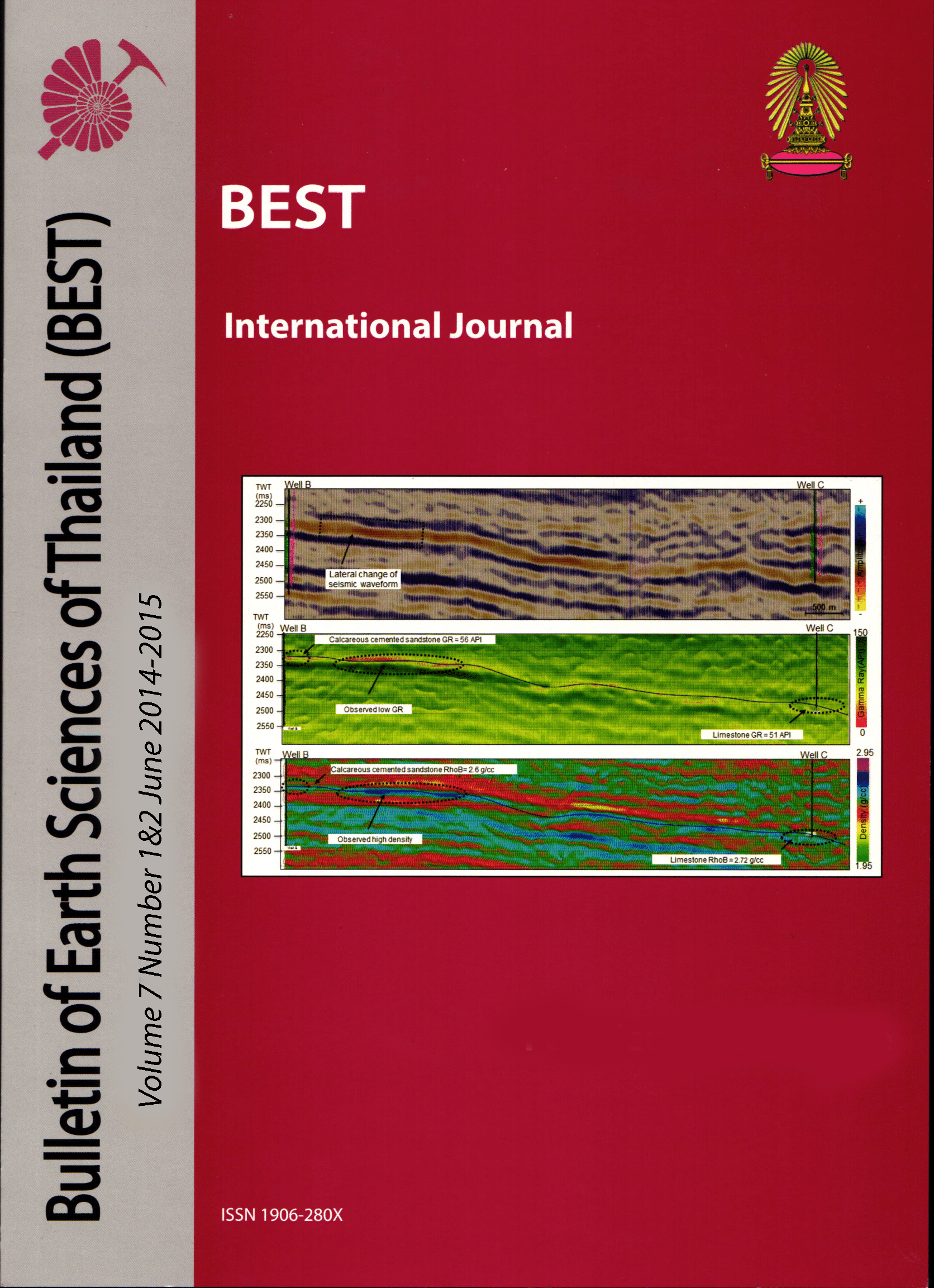Overpressure Study, Refining Wireling-based Prediction in Southern Pattani Basin, Gulf Of Thailand
Main Article Content
Abstract
The application of Eaton’s sonic log-based pore pressure prediction method is typically the pore pressure analyst’s preferred method for predicting overpressure in the Gulf of Thailand and other hydrocarbon basins in SE-Asia. However, the fracture gradient approach has not yet been used successfully for reliable fracture pressure prediction in this area. Testing the fracture gradient approach and its use in understanding overpressure generation is the focus of this study. Data from ten development wells and two exploration wells from Moragot and Funan fields were used and subjected to Eaton’s sonic-based method for computing pore pressure and fracture gradient were calculated. The results were then compared with RFT log data and LOT measures, respectively. A further comparison using TOC and vitrinite reflection measurements plotted against overpressure across three wells with organic maturation data shows that the onset of overpressure corresponds to the onset of organic maturation. It is likely that the main drivers creating overpressure in the study area are a combination of hydrocarbon generation and variable levels of compaction disequilibrium. The computed overpressure via Eaton’s sonic-based method with an exponential x factor equal to 2 gave the closest result to RFT values showing it can reliably predict overpressure in the Gulf of Thailand. Furthermore, the fracture gradient results show this approach can predict lost circulation zones in wells that had drilling issues. The sonic-based methods produce an estimated pore pressure and fracture trend, which can be useful in areas where pore pressure profiles are not well defined or sediments have experienced depletion pressures, and/or drilling problems (i.e. loss of fluid circulation or fluid influxes). When determining top of overpressure, which will affect porosity and subsurface stress, the application of these methods facilitates an approach of “filling in the gaps”. In addition, in order to minimize drilling risks, this methodology can be reliably employed as the one of techniques utilized while drilling, or in realtime pore pressure estimation (in MWD) and in calculation of mud-weight safety windows.
Article Details

This work is licensed under a Creative Commons Attribution-NonCommercial-NoDerivatives 4.0 International License.
Copyright © 2008 Department of Geology, Faculty of Science, Chulalongkorn University. Parts of an article can be photocopied or reproduced without prior written permission from the author(s), but due acknowledgments should be stated or cited accordingly.
References
Bowers, G. L., 1995, Pore pressure estimation from velocity data: Accounting for overpressure mechanisms besides undercompaction: SPE Drilling & Completion, v. 10, p. 89-95.
Eaton, B. A., 1969, Fracture gradient prediction and its application in oilfield operations: Journal of Petroleum Technology, v. 21, p. 1353–1360.
Eaton, B. A., 1972, The effect of overburden stress on geopressure prediction from well logs: Journal of Petroleum Technology, v. 24, p. 929-934.
Hoesni, J., 2004, Origins of overpressure in the Malay Basin and its influence on petroleum systems: PhD thesis, University of Durham, Durham, United Kingdom, p. 268.
Jardine, E., 1997, Dual petroleum systems governing the prolific Pattani Basin, off shore Thailand: Proceedings of an International Conference on Petroleum Systems of SE Asia and Australasia, p. 351-363.
Neuzil, C. E., 1995, Abnormal pressure as hydrodynamic phenomena: American Journal of Science, v. 295, p. 742–786.
Mouchet, J. P., and A. Mitchell, 1989, Abnormal pressures while drilling: Manuels Techniques Elf Aquitaine, v. 2, 255 p
Osborne, M. J., and R. E. Swarbrick, 1997, Mechanisms for generating overpressure in sedimentary basins: a reevaluation: AAPG Bulletin, v. 81, p. 1023-1041.
Tingay, M. R., R. R. Hillis, R. E. Swarbrick, C. K. Morley, and A. R. Damit, 2009, Origin of overpressure and porepressure prediction in the Baram province, Brunei: AAPG Bulletin, v. 93, p. 51-74.
Yassir, N and Bell, J, 1996, Abnormal high fluid pressure and associated porosities and stress regimes in sedimentary basins: SPE Formation Evaluation, March 1996., 48, 5-10.


